
Synchronicity can be quite entertaining. Especially when it comes in threes.
Back in September this year when a friend and I were returning from a weekend up at Hill End, we stopped in a small country town West of Sydney to check out something we'd heard of in the bush nearby. On the way there we found this:

It's the local community recycling center. As we wandered through it over the next half hour several cars pulled up, people dropped off assorted electronic goods discards, chatted with us, and left. Seems to be that recycling is go, in this sensible town. Good for them; none of the big city 'public liability' lunacy Sydney reeks of.

Our junk browsing was initially just for curiosity, since I already have far too much 'spare parts' old circuit boards, and my friend isn't so much into electronics. (Yet, but I think he's been bitten.)
What did interest us both was these — rear projecton TVs. There were a surprising number of them in this collection. Some trashed, some mostly undamaged.

I've never had one of these to play with, since they weren't all that common even at their peak. One thing I'd read was that the screens included a kind of fresnel lense, that was good for tricks like using as a giant sunlight condenser aka magnifying glass to burn things. A couple of the ones here had their screens pushed in, making it easy to just pull out the front sheets and separate them. There are two or three component layers of the screen, one of which is indeed a kind of fresnel lense. Not quite as 'sun focussing' as the story had made out, but still an interesting optical toy.
My friend decided he'd like a couple of these as novelty 'skylights' in a (kind of) workspace he has. So we pulled apart two of the units with undamaged screens. Which meant that I was now looking at the projection lenses, separate red, green and blue high luminance CRTs, and the drive electronics, of a unit that was undamaged.
Sigh. Irresistable. So that went in the back of the car with the big optical sheets, piled on top of the camping gear. Uh, and the recent-model inverter microwave unit, and the... you know how it is.
Then I thought that hey, the lenses on these rear projection TVs are neat too, and rather than have to take them off the CRTs I just piled in the car, why not take another set? Why not indeed. So a few more minutes...
A year or two ago I'd finally given up on getting a big theatre video projector going, that I'd had for a while. It was a giant Ampro 3300, with three huge red, green and blue tubes. I actually had three units, but only one fully intact. Was gradually accumulating technical info on them. Eventually though when I tried to get it going, it turned out they all had a common power supply failure, in which the main switchmode transformer ferrite had cracked due to mechanical stress. Irrepairable, and a real shame.
But in the course of that whole saga I'd learned that the CRT faces were immersed in a coolant fluid, between the glass and the lenses, to even out thermal stress on the glass due to the electron beam heating. With these much smaller rear projection TVs there was apparently a similar arrangement. And on lifting the lense assembly off a CRT unit, there it was — a pool of perfectly clear fluid, with a viscosity just a bit above water. But (on getting some on my fingers) it's not water; it seems to be something like a silicone oil. Hmm...
Then while carrying the lenses over to the car I nearly set my pants and a finger on fire, by forgetting that big lenses and bright sunlight are a dangerous combination. Ow! With the singed finger and taking care to pack the lenses underneath stuff so they couldn't set the car on fire too, I didn't think about that silicone oil again. For a while.

Much later that day, after another adventure and well on the way home, I slapped my forehead. Oh darn! I know something I'd like a lot of that liquid for! But way too late now. Even if I had a container to put it in, and something to cleanly salvage it from those old TV sets, we're simply not going to drive all the way back there just for that. Maybe next time I drive over the mountains.
Back home again, the guts of the projection TV got stored in a shed. Thinking I should try to find a circuit diagram. It would be fun to set up a monochrome blue console terminal or something, projected on a wall. Actual colour TV, bleh, not interested. It's been years since I watched any broadcast TV, and anyway I never understood this 'big screen' fascination people seem to have, or why anyone would actually buy and clutter up their home with these hulking great rear projection monstrosities in the first place. Besides, LCD screens.
What I would like most of all, is a big bottle full of that low viscosity silicone oil for an art-experiment I have in mind. But there's not enough in the three lense sets of this one projector to be worthwhile stripping the lenses.
Both those project ideas went on the bottom of the list, which generally means 'never going to happen.' Also while I have seen projection TVs tossed out on the street before, that was only very rarely. I couldn't even remember when I last saw one. So I didn't expect I'd see another any time soon.
About 10 days later on a trip to the local post office, there was one, on the kerb right by where I normally park. It had only just been put out, and had a sheet of plastic put over it to keep rain off. I literally only had to walk around the car, open the back, slide the huge great TV off the top of the stack of discarded mattresses and other old furniture onto the street, roll it a couple of feet, and heave it into the car.
Only when I got it home, did I realise it was a virtually identical model to the one I'd gutted in that country recycling pile. I hadn't noted the model number on that one, but here are their rear connector panels.

Left: from country town. Right: from near my post office, a Samsung Model SP-43T5HP.
Huh. What are the chances? I shrugged and put that one on the bottom of the todo list with the first one.
A few days later, a friend contacted me and said "Hey, there's a big rear projection TV on the street near my place, here's the address if you want it." What, suddenly it's raining these things?
The address he'd given wasn't far from the hardware store, that I had to go to anyway. So went to look at the TV on the way. Found it's huge; will not fit in car. Also far too heavy to lift onto the roof racks by myself. But there just happens to be a tradesman guy changing his boots at his car a few meters from where I'd parked. I ask him if he'd mind helping. It's still too heavy and awkward for us to lift together, but... his mates are just knocking off from the building site across the road. Five of us together have no problem getting it up on the racks. I thank them. They're confused about why I'd want it. I sort-of explain, and they head off home. Then I spent 15 minutes roping it on. Awkward object is awkward, and very silly looking perched on top of my car.
Naturally neither of the TVs had come with their remote control, and neither would power up. The aim was never to get them working anyway. I mostly just wanted the optically clear, inert and non-clouding liquid from the lense assemblies. Also curiosity, to see how they were put together. Meanwhile, together they were taking up most of the spare floorspace in my 'storage' shed. So their end came fairly quickly.
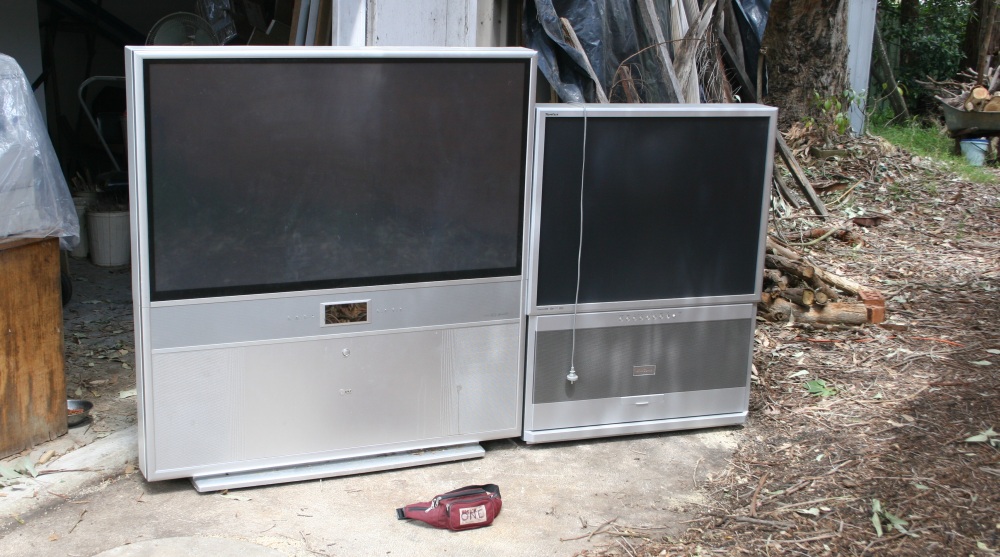
The forlorn couple, standing in line before the executioner toolset.
Larger LG Model RT-56NZ23RB on the left, Samsung Model SP-43T5HP on the right.
Click on thumbnails for larger images.
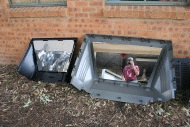
|

|

|

|
The backs come off first. The smaller one has a nice big front-silvered mirror. The larger one has something even cooler — a very lightweight mirror made by stretching a reflective metalised plastic film over an aluminium frame.
The internal electronics are laid out very similarly in the two units.
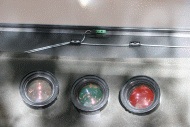
|

|

|

|
Both units have a thin 'dust barrier' open cell foam sheet allowing cooling air convection into the upper cabinet. Of course they had to be different with the order of the RGB tubes.

|

|

|

|

|
Naturally the 'dust filter' wasn't insect proof. The large unit has cobwebs hanging inside. By the time I took these photos they were tangled up from blowing in the wind, but I expect that cobwebs, and even spiders floating around in the rising current of warm air from the electronics must have produced some rather annoying moving shadows on screen while in use. And there's no easy way to clear them out.
Ha ha ha... I wonder if that was a common problem among owners of these things? "Arrgh! My picture has spiders again!"
Both units have small optical sensor boards placed all around the inside edges of the front screen, so there must have been some form of automatic image alignment system. Also these machines have the largest injection molded plastic casings I've ever seen.

|

|
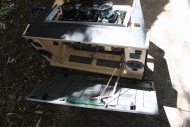
|
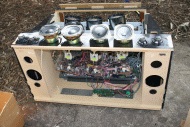
|

|

|

|

|

|
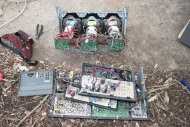
|
So many wires and connectors. Taking lots of photos, just in case I ever wanted to get these things running in some fashion. There are predominantly just two modules — a carrier base with all the main electronics boards, and a metal frame supporting the three CRTs, lenses, and a few small associated boards.
All hung together in the cheapest chipboard frame you could imagine.

|

|
A roll of salvaged stainless steel wire mesh. Useful!

|
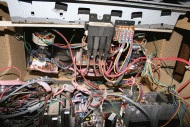
|

|

|

|
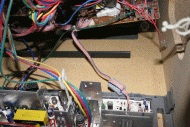
|

|

|
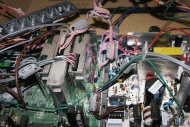
|

|
Never mind the wheels, isn't it time for dinner?

|
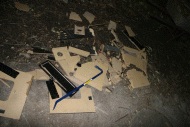
|
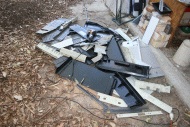
|
Volume-reducing the cabinets, Gordon Freeman style.
Well, except that I never saw Freeman using a jig-saw. Or rolley bins.
After this the electronics bits got stowed in the storage shed, due to other chores taking priority. Hmmm. So I still haven't extracted the silicone oily goodness from these units. Which was supposed to be the whole point.
I still want more of that too. It's an inert, optically clear liquid, that won't develop mold or catch fire while heated. I want it for an experiment involving optics and convection currents in liquid. If anyone sees any more back projection TVs thrown out in Sth Sydney, please let me know. Or if anyone knows what it's called, what it costs in bulk, and where to buy it, I'd appreciate that too.
Also, does anyone know of an online source of schematics for these old projection TVs?